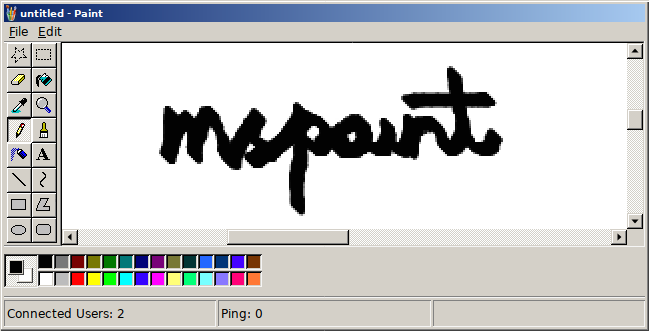- complete realtime support
- classic mspaint tools
- public domain
There are many mspaint clones on the web, of varying levels of completeness.
In this implementation, everyone shares the same canvas. Pixel drawing, UI updates, mouse events or similar are displayed to everyone in realtime.
The style is based on win98 paint, except the icon. I prefer the other icon.
A main focus has been to be fast and lean. Keeping the script payload low, using vector art where possible, reducing traffic required. Canvas drawing operations particularly seem to require optimizations for decent speed.
Providing the state of the canvas to the user quickly to reduce the time to first paint has been the subject of much thought. Sending a raw Uint8ClampedArray down the wire after getting a websocket connection just seemed way too slow.
The canvas is rendered serverside with node-canvas. This can produce PNGs, so I set up a route for accessing the current state as a PNG.
So, this is embedded in the initial markup as an <img/> tag and is copied to the canvas when finished. This means that the data can be loaded async before any scripts are reached.
I tried applying lossless compression to the image before sending it, but this seems to take more time than is saved by reducing the image size. This could be cached instead, but the state would be out of date. It feels like there are endless tradeoffs to consider.
The fragments of user UI seen in the workspace are generated from a nonstandard virtual DOM representation and are shared as an initial state then patched. This is then rendered using Preact.
All of the code for interacting with the canvas and virtual DOM is shared between front and backend.
Initially communication between client and server was done via JSON strings, which seemed quite wasteful. Using something like msgpack or protobuf would improve this, but would incur a significant bundle size penalty. Therefore, a custom format has been created.
A notable detail is that property names or enums are all preindexed and reduced to single bytes.
This method of packing / unpacking of data is much slower than JSON, but gives a huge reduction in data size.
This project seems to work in most browsers, mobile even has multitouch support. Older browsers need to download a polyfill and incur a performance hit, newer ones can skip it. Open an issue if it's broken anywhere.
For the scrollbars, I could not find a universal solution for styling them natively, so ended up rolling my own. This was pretty awful to do - d3's d3-scale module would have added 63kb to the final bundle size (why doesn't tree shaking work properly in webpack 2?), so I went without it.
├── development/ - development tools
│
├── server/ - backend code
│ └── index.js - base script
│
├── shared/ - universal code
│ ├── canvas/ - canvas drawing
│ ├── vdom/ - virtual DOM
│ └── constants.js - configuration
│
└── web/ - frontend code
├── bundles/ - transpiled modules
├── modules/ - scripts and styles
├── static/ - other assets
└── root.js - entrypoint
- multiple rooms
- nicknames / better multiplay
- canvas history
- mspaint.us/canvas.png a PNG of the current canvas
- jspaint similar project
- virtual x86 for quick testing
- kbd_mspaint keyboard documentation
- easyfilter line drawing algorithm

To the extent possible under law, all copyright and related or neighboring rights to mspaint have been waived.






